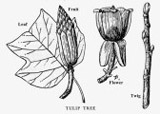Tulip tree is one of our most distinctive and attractive trees. It is native from Saratoga and Rensselaer Counties westward along Lake Ontario to Lake Erie, and becomes more abundant southward in deep, rich, moist soils. Its large tulip-like, greenish yellow flowers have given rise to the name "tulip tree." The wood is light, soft, brittle, not strong, straight-grained, light yellow or brown in color, and is largely made into lumber and interior finish and used where a soft, easily worked wood is required. Veneer of yellow-poplar is highly prized in airplane construction.
